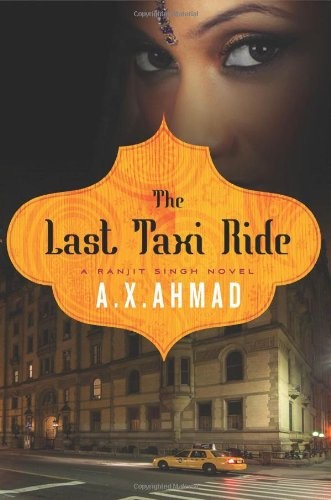Guest post by Holly Jones

Writing a thriller set in New York with a South Asian protagonist is far easier said than done in these charged, geopolitically aware times. But A.X. Ahmad’s The Last Taxi Ride reaffirms how successfully such a work, in the hands of an aware, skilled writer, can simultaneously entertain and inform our understanding of the world without being crushed under the weight of cultural and immigrant sensibilities.
Ahmad introduced the world to ex-Indian Army Captain Ranjit Singh in The Caretaker, the first book in the trilogy, which showed Ranjit as a new immigrant struggling to provide for his wife and daughter on Martha’s Vineyard until he landed a job minding the home of a US senator and his compelling, complicated wife. A mysterious break-in at the senator’s home landed the Singh family in trouble. Ranjit managed to unravel the mystery behind the break-in before time ran out for all of them, but by the story’s end, neither his marriage nor his fragile sense of home in this new world had gone unscathed.
As the second novel opens, a now-divorced Ranjit Singh has transplanted himself to New York City. He works two jobs, awaits his daughter’s arrival and spends his nights alone in a basement apartment whose mirrored tiles distort more than mask its smallness. All of this changes when a beautiful has-been starlet named Shabana Shah is found dead after riding in his taxi and he’s accused of being an accessory to her murder. The outlook is grim and time short to produce proof of his innocence, but hope appears in the form of his employer, promising help if Ranjit finds Mohan, a military buddy from his past and the primary suspect in the murder case. Armed with a gun, cash and few leads, Ranjit sets out to find Mohan. He journeys into New York City’s many neighborhoods and worlds and, for the most part, it’s one heck of an enjoyable ride.
New York is a much more complex landscape than Martha’s Vineyard, yet, as with The Caretaker, Ahmad makes skillful use of the setting to underscore mood, conflict and metaphor to the story’s advantage. The Jamaica Bay shoreline isn’t just a convenient spot for Ranjit to interrogate his best lead on the case; it’s also a place where people pray and bring offerings for their gods. Central Park takes on heart and soul when described as “a vast darkness illuminated by the globes of streetlights.” Little Guyana, in the heart of Queens, becomes more than just a neighbourhood: in Ahmad’s hands, it becomes a map of one immigrant’s loneliness. “Everywhere Ranjit sees India, but somehow distorted, the colors wrong, the smells unfamiliar,” Ahmad writes.
In fact, there is not a single scene in The Last Taxi Ride that doesn’t, at some point, call to our attention how life in New York looks and feels for newly-arrived foreigners. The occasional heavy-handed reference aside, Ahmad wields his pen with a light, knowing touch so that readers, and particularly those not from South Asia, read a passage like the one below and grasp instantly the location, a world largely unfamiliar to them and the emotions that will help and hinder Ranjit’s search: “Some shopkeepers are brushing at their wares with colored feather dusters, and that gesture reminds him of India as does the smell of incense drifting out of the small shrines in the shops. How strange, he thinks, to transplant Indians to the Caribbean (and then to New York), where they lose their language, and all their memories of India. All that remains are these scattered gestures.” Ahmad echoes and deepens this sense of what it means to make one’s way through a new world over the course of the novel so that, by the end of the novel, it is as much a part of the setting as these characters’ new home, New York City, and the two are as interwoven in the reader’s mind as they are for the characters forging their new lives.
Ahmad has cast many compelling plot lines in The Last Taxi Ride and, at times, I felt there were too many. The primary plot thread belongs to Ranjit and his quest to find his friend and the truth behind the crime. But subplots multiply as the story unfolds: Ranjit’s mourning of one love lost as new love – or something resembling it – finds him, the power struggle between has-been starlet Shabana and her sister, Ranjit’s employer’s import business and what it really ships, the organized crime ring somehow tied to so much of this, and more. It’s a lot for one hero to resolve in 368 pages but Ahmad does a credible job tying up all the plot lines and concluding The Last Taxi Ride with possibilities, versus loose ends, for the third book of his trilogy.
As I read The Last Taxi Ride, I often found myself smiling, cringing or both and that was, for me, the mark of a solid read and Ahmad’s promise as an author. He infuses the thriller with delightful notes like a Greek chorus of taxi drivers, running jokes that only get better as the plot progresses, and lyrical passages that deepen, rather than slow, the overall narrative. He brings Ranjit to life with moments of such steely judgment and grit – my favorite being one involving pancakes, syrup and rats – that the quantity, or lack thereof, was one of my few gripes with the work. I wanted more of the tough hero moves former military officer Ranjit Singh must be capable of wielding. But, if the momentum Ahmad developed over the story keeps building, we’ll see Ranjit as an even more fully realized thriller hero in the third and final novel of the trilogy.
If you haven’t read The Caretaker, I recommend reading it before diving into The Last Taxi Ride. Read slowly, because we have another year or so to wait for the next Ranjit Singh novel.

Holly Jones has authored short stories, essays, and articles for various magazines, including the “Dispatches From The Anacostia” and “Dispatches From The Capital” series for McSweeney’s Internet Tendency. She co-founded the literacy non-profit 826DC, and holds an MFA from Vermont College of Fine Arts as well as an MBA from Stanford University Graduate School of Business. She is currently working on a thriller set in Pakistan.


















